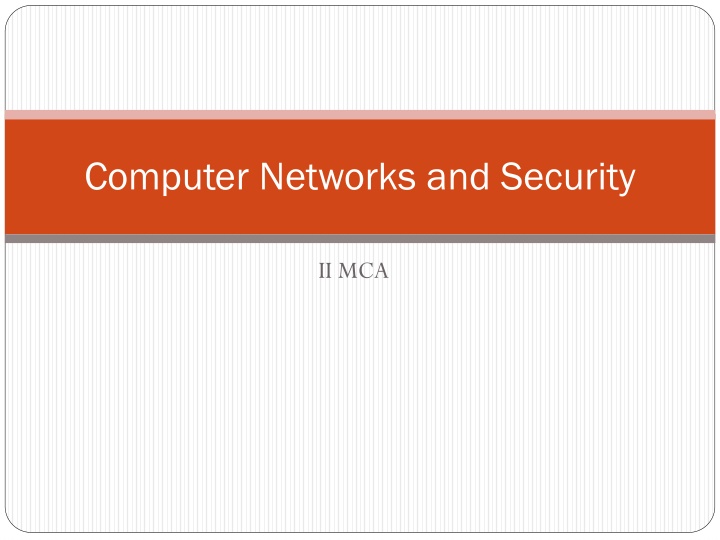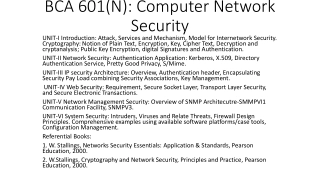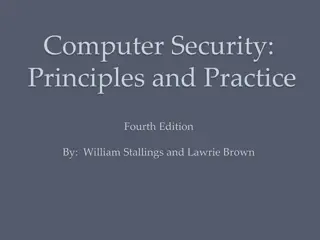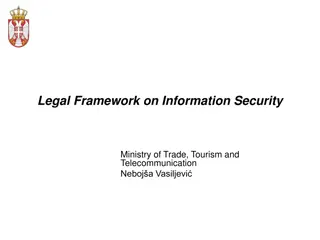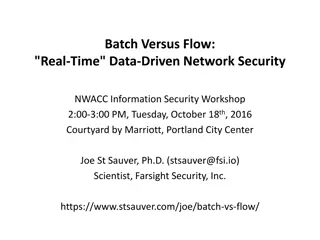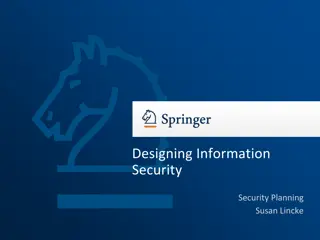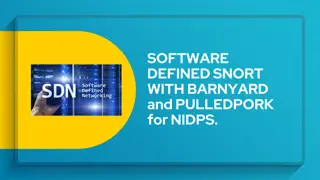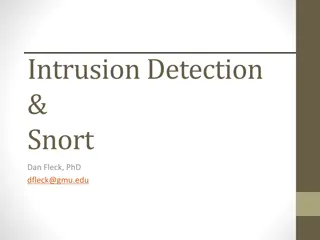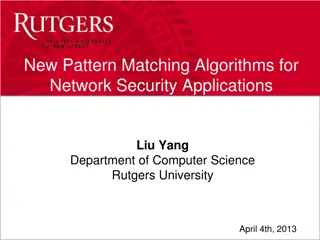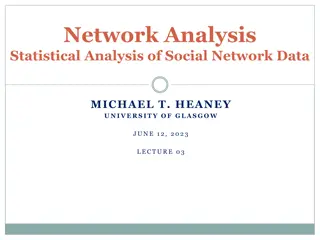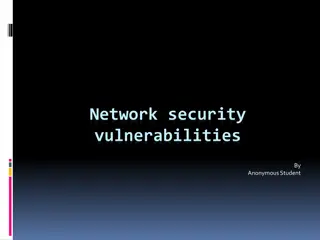Network Security Principles and Techniques
Explore the fundamental concepts of network security, including issues of confidentiality, integrity, and non-repudiability. Learn about the challenges of securing networks and the types of attacks that computer systems face. Dive into basic security techniques like hashing and symmetric key cryptography, and understand the principles behind them. Discover how hashing works as a one-way function, different hashing algorithms like MD5 and SHA1, and the principles of symmetric key cryptography using a single secret key.
Download Presentation

Please find below an Image/Link to download the presentation.
The content on the website is provided AS IS for your information and personal use only. It may not be sold, licensed, or shared on other websites without obtaining consent from the author.If you encounter any issues during the download, it is possible that the publisher has removed the file from their server.
You are allowed to download the files provided on this website for personal or commercial use, subject to the condition that they are used lawfully. All files are the property of their respective owners.
The content on the website is provided AS IS for your information and personal use only. It may not be sold, licensed, or shared on other websites without obtaining consent from the author.
E N D
Presentation Transcript
Network Security-Issues Confidentiality/Secrecy Data is only understandable to the communicating parties Authentication Can you prove who you are? Integrity Did you get the message I sent? Non-repudiability Yes you did!
Network Security - Why is it difficult? Complexity. Resource sharing. Unknown Perimeter. Many points of attack. Anonymity. Unknown Paths.
Basic Security Techniques Hashing Symmetric Key Cryptography Diffie-Hellman Key Exchange Public Key Cryptography
Hashing Analogous to fingerprints A way to identify people Don t change with time Easily taken Small Cannot generate the persons One Way Function Given x it is easy to compute y = f(x) Given y it is hard to compute x = f-1(y).
Hashing Principles Can be applied to data of any length Output is fixed length One way function Relatively easy to compute h(x), given x. Infeasible to get x, given h(x). Collision resistance Weak collision resistance: given x, it is hard to find y x such that H(y) = H(x). Strong collision resistance: it is hard to find any pair x and y(y x) such that H(y) = H(x). The strength mostly depends on the size of the hash result
Hashing Algorithms MD5(16 Byte hash result) SHA1(20 Byte hash result) Note Hashing alone can t prove integrity Hashing result is also called: Hash, digest, fingerprint, analysis, message digest
Symmetric Key Cryptography Principles Use a single secret key The cipher text has almost the same size as the original message Built on a shared secret or some random unpredictable data The strength mostly depends on the key length Encrypt large files fast and efficiently Go by many names(session key, single key, bulk encryption)
Chopping Chop the message into blocks Perform math operations on each block Message Block # 1 as character Drew's typical data. Could be numbers, letters, image, sound, video. It doesn't matter, it's all data and it all gets stored as bytes of information Drew's t
Initialization Vectors Goal: making each repeated message unique Approach: inserting some random data at the beginning of a new message Message Add the IV and the message Hey ATM machine, please give me $100 abcd1234Hey ATM machine, please give me $100
Chaining Mode Chaining Mode controls how the encryption combines the results of encrypting many blocks in a single message A message with patterns Encryption without chaining aaaaaaaa aaaaaaaa AD942241384D4237 AD942241384D4237
Cipher Block Chaining(CBC) combines each block to be encrypted with the encryption of the previous block to hide pattern Encrypt block 1 aaaaaaaa - Block1 as ASCII characters 61-61-61-61-61-61-61-61 - Block1 in Hex notation 56-61-04-D7-1A-EC-8C-10 - Cipher text result for Block1 Encrypt block 2 aaaaaaaa - Block2 as ASCII characters 61-61-61-61-61-61-61-61 - Block2 in Hex notation 56-61-04-D7-1A-EC-8C-10 - Block1 1 Encrypted B7-C2-65-38-7B-4D-ED-71 - Block2 + (block1 encrypted ) Hex 80-C2-00-8E-00-C0-00-00 - Encrypted (Block2 + encrypted block1)
Symmetric Key Encryption/Decryption Processes Encryption Process Pad the message to the nearest multiple of 8 bytes. Add an initialization vector to the front of message Use chaining to combine the results of the previous block Encrypt each block of data sequentially Decryption Process Decrypt each block sequentially Use chaining to undo the results of the previous block chaining from the current block Remove any initialization vector data at the front of the message Remove any padded bytes at the end
Symmetric Key Algorithms DES, 3DES Rijndael (AES Winner) IDEA Twofish Blowfish RC4, RC5, RC6 Serpent MARS Feal
Diffie-Hellman Key Exchange Algorithm 1. Choose public numbers: P (large prime number), G (<= P) 2. A generates random R1and sends B: S1= GR1mod P 3. B generates random R2and sends A: S2= GR2mod P 4. A calculates secret key: K = (S2) R1mod P = GR2R1mod P 5. B calculates secret key: K = (S1) R2mod P = GR2R1mod P
Diffie-Hellman Usage Used in SSL, SSH, IPSec, Cisco encrypting routers, Sun secure RPC and etc... Several groups Group1 Diffie-Hellman exchanges uses moderately large prime numbers Group2 Diffie-Hellman exchanges uses very large prime numbers
Public Key Encryption Two keys: public encryption key e private decryption key d encryption easy when e is known decryption hard when d is not known decryption easy when d is known The most famous algorithm: RSA
RSA overview - setup Alice wants people to be able to send her encrypted messages. She chooses two (large) prime numbers, p and q and computes n=pq and z=(p-1)(q-1) She chooses a number e such that e is relatively prime to z She finds a number d such that ed-1 is exactly divisible by z She publicizes the pair (n,e) as her public key. She keeps (n,d) secret and destroys p, q, and z
RSA overview - encryption Bob wants to send a message x to Alice. He looks up her public key (n, e) in a directory. The encrypted message is Bob sends y to Alice. = = emod ( ) y E x x n
RSA overview - decryption To decrypt the message After Alice receives the message from Bob, Alice computes = = emod ( ) y E x x n Claim: D(y) = x Symmetric key cryptography is at least 100 times faster than RSA y y D ) ( = dmod n
Tiny RSA example. Let p = 7, q = 11. Then n = 77 and z = 60 Choose e = 13. Find d = 13-1mod 60 = 37. Let message = 2. E(2) = 213mod 77 = 30. D(30) = 3037mod 77=2
Combinations of Basic Techniques HMAC Hashing Message Authentication Code Digital Signature and Signed Hashes Digital Envelope
MAC Mechanisms that provide integrity check based on a secret key MAC algorithm could be made out of a symmetric cipher Can be thought as a checksum Assume message M, shared key K MAC(M) = e(M||K)
MAC Process 1. 2. 3. A sends M & M1=MAC(M)=e(M||K) B receives both parts B makes his own MAC, M2 = e(M||K) If M2 != M1, data has been corrupted If M2 == M1, data is valid MAC may not be used for non-repudiation 4.
HMAC Combines a hashing function with a secret shared key HMAC = HASH(M||K) HMAC can be used with any iterative cryptographic hash function, e.g., MD5, SHA-1, in combination with a secret shared key. Computationally faster and compacter than MAC Used in IPSec
Digital Signatures Desirable properties of handwritten signatures: Signed document is authentic. Signature is unforgeable. Signature is not reusable. Signed document is unalterable. Signature cannot be repudiated. (Above not strictly true but mostly so) Same properties and more can be achieved by digital signatures. Digital Signatures use public key cryptography.
RSA based signature Alice signs Signed message Bob verifies Message Message Encrypt With Private key Decrypt With Public key Hjkhrk Hj837* *ji8hj] Hello, I love you Hello, I love you Alice signs message by encrypting with private key. Bob decrypts message with Alice s public key. If meaningful message then it must have been encrypted with Alice s private key!
Signing With Message Digests Figure 1: The process used to create a Digital Signature Figure 2: The process used to verify a Digital Signature
Digital Envelopes With digital signatures, the data is transmitted in the clear A digital envelope uses a one-time, symmetric key (nonce) for bulk data encryption
Digital Envelopes Figure 3: The process used to create a Digital Envelope Figure 4: The process used to verify a Digital Envelope
Create a Digital Envelope Carrying Digitally Signed Data
Verify a Digital Envelope Carrying Digitally Signed Data
Security and Network Layers But where shall we put security? Security can be applied at any of the network layers except layer 1 (Physical layer). Even this is sometimes possible, e.g. spread spectrum techniques for limited privacy. What are the pros and cons of applying security at each of these layers?
Security and Network Layers Data Link (Network Interface) layer: covers all traffic on that link, independent of protocols above protection only for one hop . Network (Internet) layer: covers all traffic, end-to-end. transparent to applications. little application control. application has no visibility of Internet layer. unnatural, since network layer is stateless and unreliable. order of data in secure channel may be crucial. difficult to maintain if IP datagrams are dropped, re-ordered,
Security and Network Layers Transport layer: end-to-end, covers all traffic using the protected transport protocol. applications can control when it s used. application has greater visibility of transport layer. transport layer may be naturally stateful (TCP). applications must be modified (unless proxied). Application layer: security can be tuned to payload requirements. different applications may have radically different needs. eg VoIP applications versus sensitive data transfer. no leveraging effect every application must handle it s own security.
